So you’ve got a harmonica, now what? Well, certainly some fun is to be had just blowing and drawing on a harmonica (check out my lesson Harmonica Chords for Beginners for some ideas about this). But eventually, if you really want to be able to rock hard, you’re gonna have to learn how to play single notes.
Single Notes for Beginners + Learn To Play “Low Rider” by War!
The harmonica is a unique instrument in that it’s easier to play two or three notes than to play just one note at a time. We have to learn a technique to isolate notes. When I first started playing the harmonica, it took me many days and days of trying before I could play single notes, and I felt frustrated. I’m going to share some tips with you to help you learn it faster and easier.
There are two main techniques used for playing single notes. They are most commonly referred to as the “tongue-blocking” and the “pucker” techniques.
Tongue-Blocking
Tongue-blocking has many disadvantages as a technique to isolate notes on the harmonica: it is a more awkward technique to learn, it takes longer to master, it’s very difficult to bend notes using it, and it’s difficult to play high notes. Learning it first could be enough to make someone want to quit learning harmonica at all!
It also does have some advantages. It produces a “fatter” tone, makes available some rhythmic chordal techniques, and is the foundation of other intermediate and advanced techniques such as tongue slaps, flutters, and octaves. Most would agree it’s an integral part of that dirty, amplified, Chicago Blues sound.
However, It Is Not a Beginner Technique, and Therefore Is Not the Subject of This Lesson.
And you can still get awesome tone without tongue-blocking. Listen, I played harmonica for over 25 years before I ever learned to isolate single notes using the tongue-block, and over that time I have been hired to play harmonica on hundreds of gigs and recording sessions. Furthermore, Paul Butterfield, Sonny Terry, Howard Levy, and John Popper, just to name a few, have all had successful careers as harmonica players without utilizing tongue-blocking to isolate single notes. So don’t let any harmonica nerds out there tell you that “you’re not a real harmonica player if you don’t tongue-block, man!” That’s just plain nonsense. Now let’s get on with it….
The Pucker
Allow me to teach you the fastest and easiest way to get up and running playing single notes and sounding great on the harmonica. The technique is most commonly referred to as “the pucker,” and I’ve heard some people call it the “lip purse”. But here at harmonica.com, we prefer to call it the “lip blocking” technique, or the “semi-pucker” because truly only the bottom lip should do the puckering.
The problem with words like “pucker” and “purse” is that beginners hear them, and, almost without fail, they will tense up their lips. Actually, even without mentioning those words, beginners tend to play with too much tension in their lips and jaws. Tension in your lips and jaw is actually your worst enemy! It’s the #1 mistake I see beginners make, time and time again. So, before you do anything, just stop and take a nice, deep breath and relax. Remember, don’t try harder, try easier! Keep it loose. You don’t have to work at this so much, as just to play with it! Keep it light.
(Tip: If you want to go deeper on this and all the other techniques on this page then check out my complete beginner course where we’ll drill your technique to perfection 🙂 )
The Deep Relaxed Mouth Position
Getting a deep relaxed mouth position on the harmonica will set you up for success with playing single notes. The two main keys here are: keeping the harmonica deep inside a relaxed top lip, and keeping your bottom lip unfolded. Having said that, follow these simple steps to success:
- Grab your harmonica with hole 1 on the left and hole 10 on the right.
- Lick your lips, relax them and place the harmonica in your mouth.
- Rotate the harmonica slightly back so that the part not touching your lips is tilting up toward the ceiling. Tilt it up about 30 degrees like this:
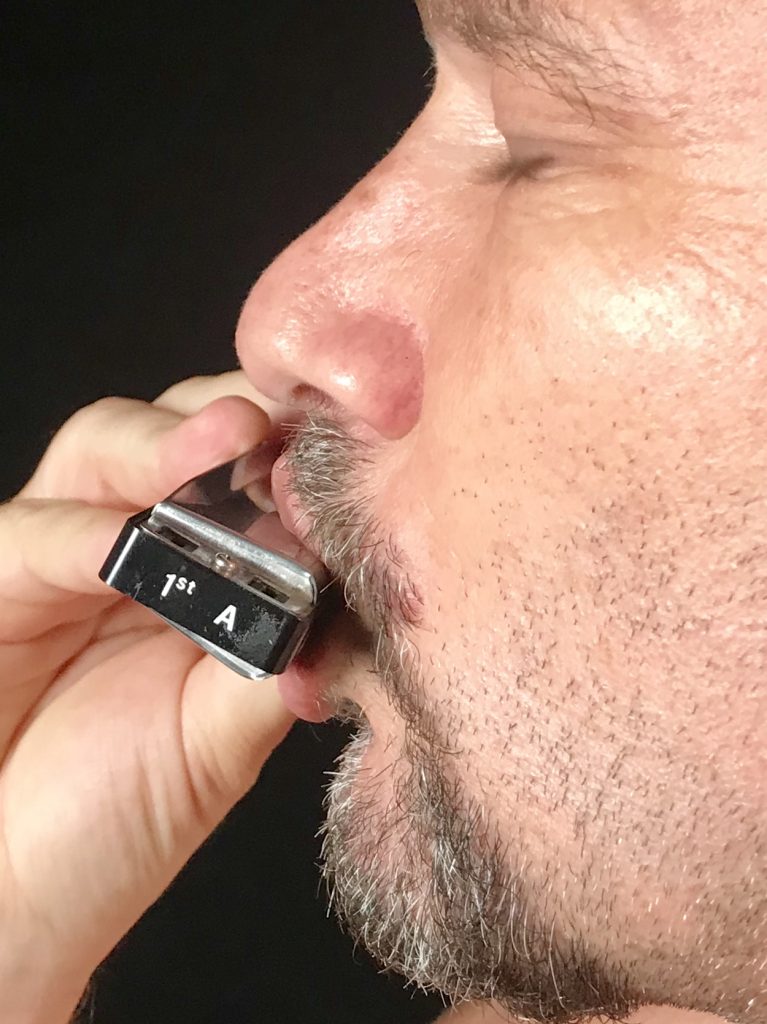
- Make sure the harmonica is deep inside your top lip. (Don’t tense up your top lip! If you have a smart phone, take a selfie, or grab a hand-held mirror to ensure that your top lip is relaxed, and that the harmonica is very deep inside of it.)
- This is probably the most important part: UNFOLD YOUR LOWER LIP so that the harmonica is contacting the moist inner part of the lower lip.
- Using your fingers on your hand that’s not holding the harmonica, pull down on your lower lip to make sure that it’s unfolded. Like this:
- If you’re doing this correctly, you’ll feel that the harmonica is actually slightly deeper inside of your top lip compared to your unfolded bottom lip.
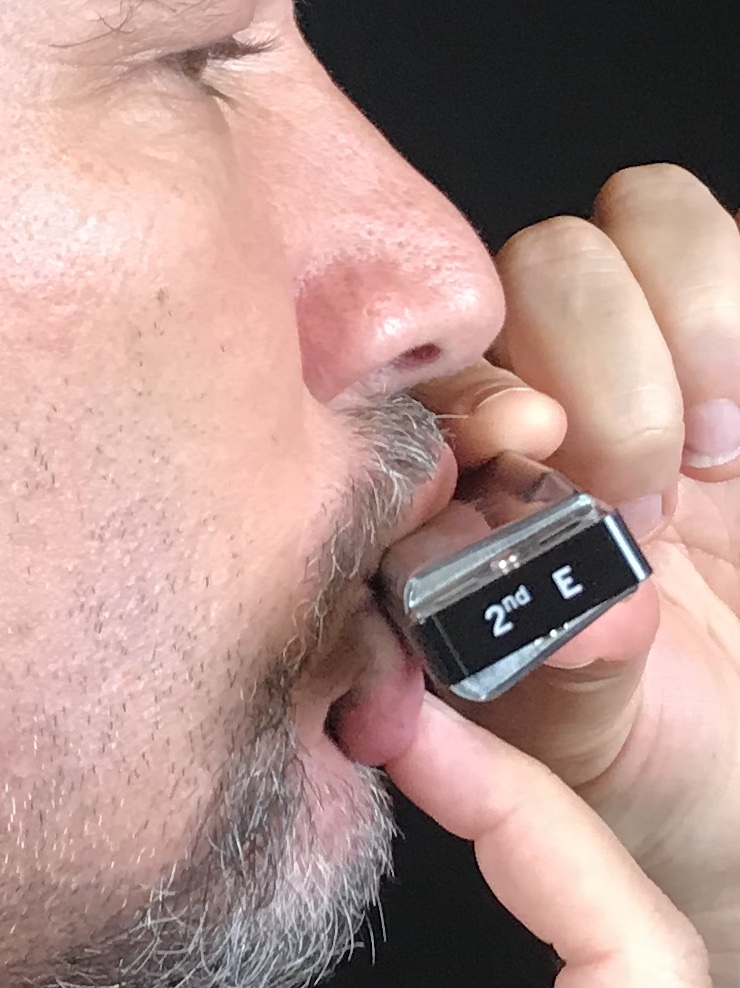
Playing Single Notes (the Best Way, Using Lip Blocking)
If you skipped the last section, go back and check it out because maintaining that nice relaxed upper lip with the harmonica deep inside of it, and the unfolded lower lip with the harmonica against the inside of it – this is your foundation for success.
Now let’s try and play a single note blowing on the 4 hole. Your lower lip will accomplish this for you if you bring the corners of your mouth together slightly so that your lower lip curves. The sides of it end up blocking holes 3 and 5, so that all we hear is the nice clear single note of the blow 4 hole. You could think of this as a semi-pucker because your lower lip is curving, but your top lip is just staying relaxed with the harmonica deep beneath it.
If you take the harmonica out from your lips, your lips should look like this:
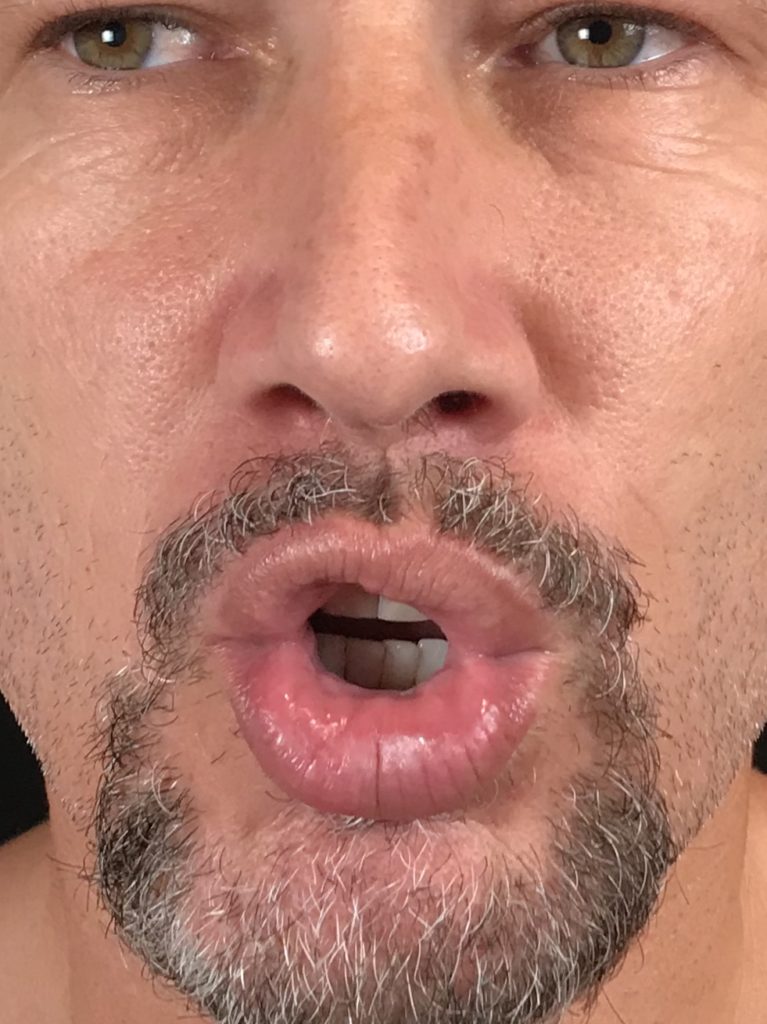
Now see the image below, you never want to look like this when you’re playing the harmonica:
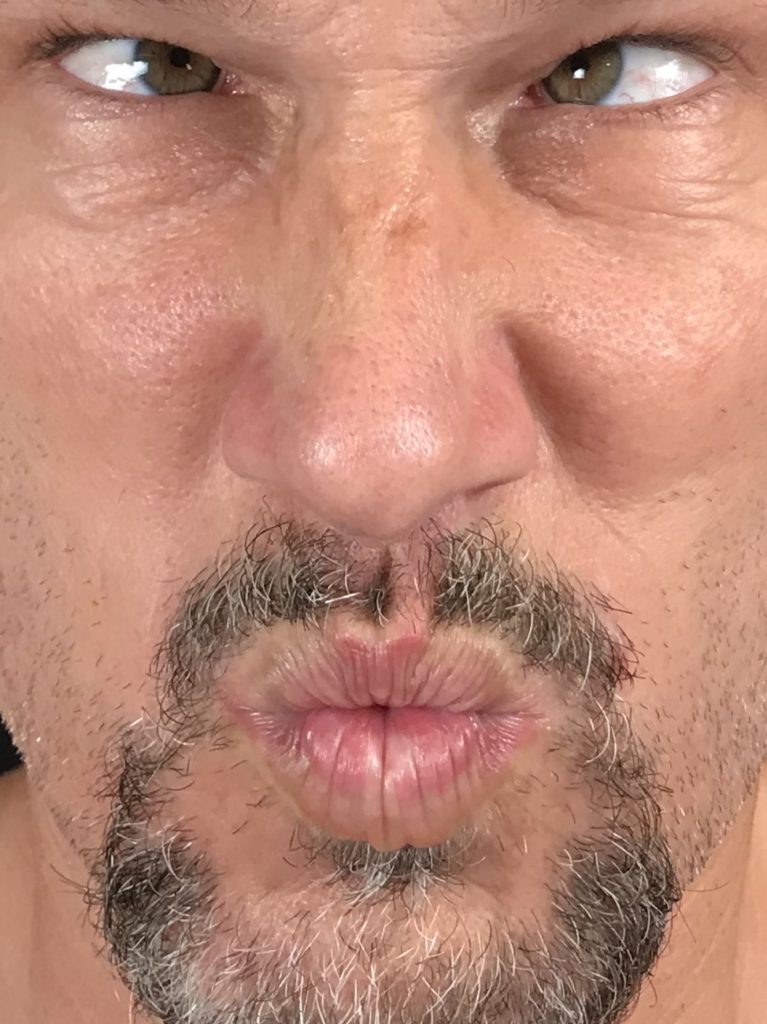
In the first picture, my lips are relaxed, I’m drawing the corners of my mouth closer together, and my jaw is also low and relaxed.
In the second picture my lips are tight, my jaw is tight, and my eyes are crossing because I’m trying waaaay too hard! Remember, don’t try harder, try easier!
I want to emphasize again that your upper lip is not involved in the isolating of the note. It’s just sitting up there all cool and relaxed, keeping a nice air seal on the harmonica because of the harmonica’s position deep inside of it, and it’s just cruising along up there, going along for the ride.
If you’re not sure whether or not you’re playing a single note, you can literally cover holes 3 and 5 with your fingers and blow into the harmonica, so you can hear clearly how it should sound, like this:
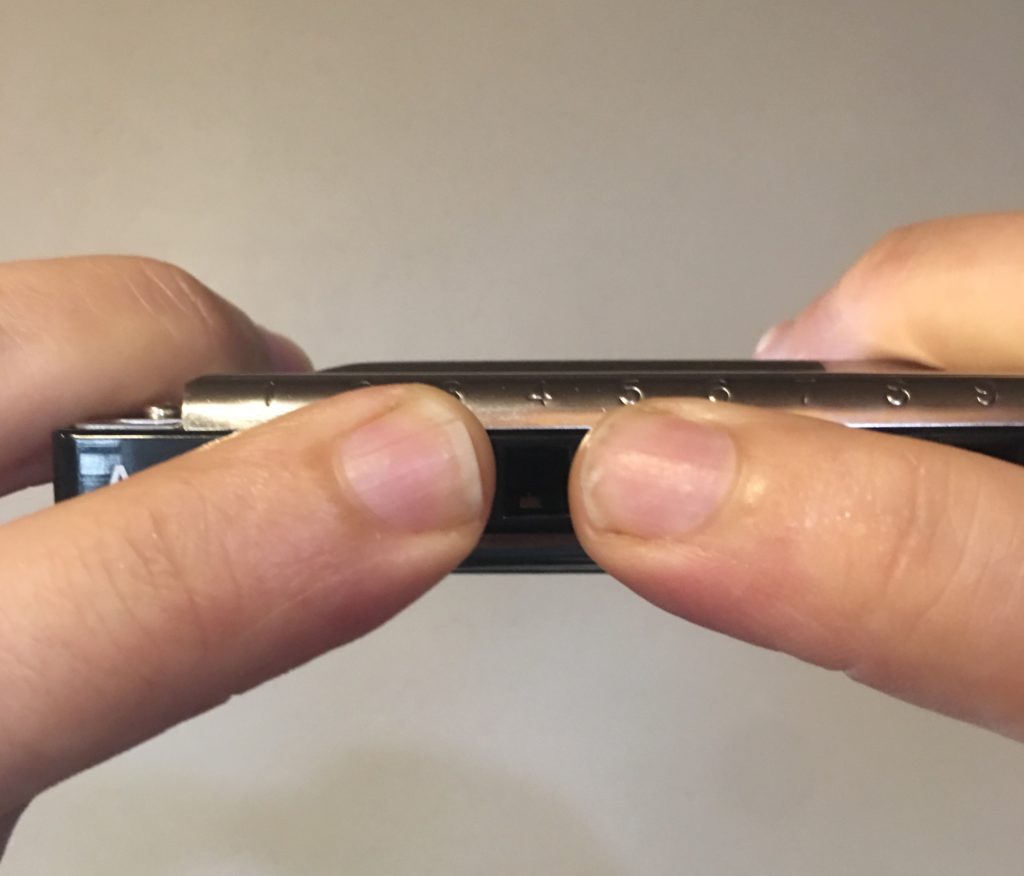
Lip Blocking All the Notes
Now if you’re still struggling to get a clear single note, put the harmonica in your mouth using the relaxed mouth position described above, and tilt the harmonica all the way back so that the back of it is literally pointing at the ceiling.
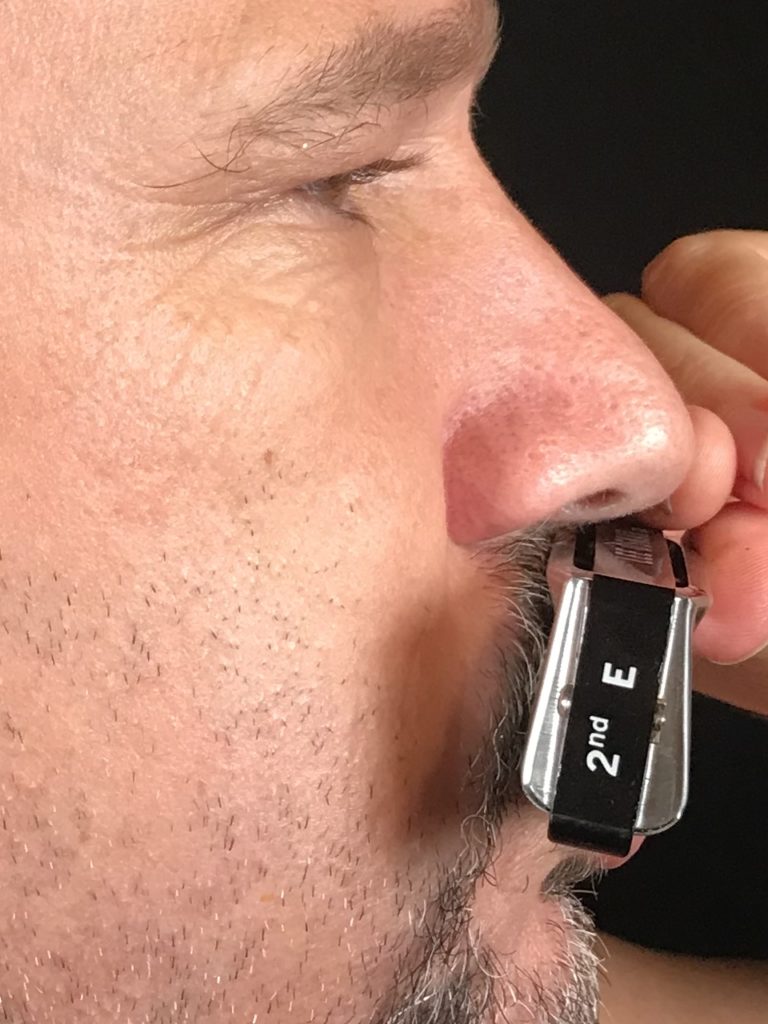
At this point, no sound is coming out because your bottom lip is blocking all of the holes. Now, ever so slowly rotate it down until you hear that one clear note.
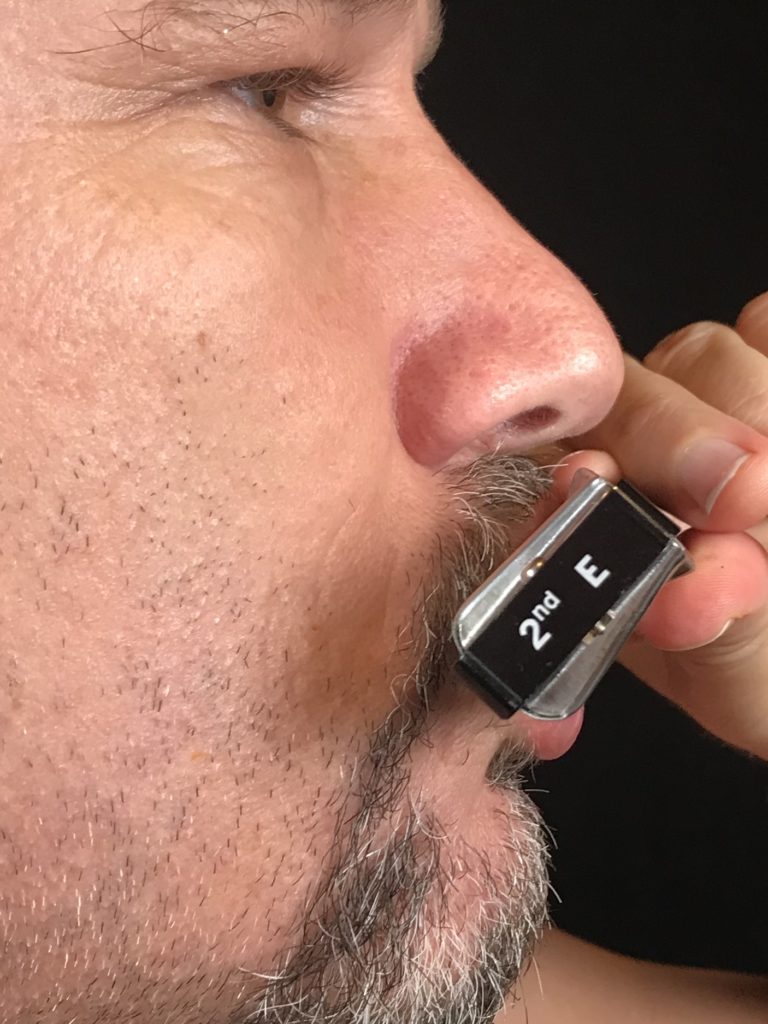
Keep rotating it until you hear more. Just keep playing with this.
Now, if you’re getting single notes, but only while keeping the harmonica at an angle, you might be thinking, “I don’t want to always have to tilt the harmonica back in order to play single notes!” Don’t worry about that. With time, your mouth will figure out what it’s doing, and you’ll be able to isolate notes without any tilt on the harmonica. It may take weeks or even months, and that’s just fine!
Once you are able to isolate the 4 blow, try moving around playing single notes on other holes on the harmonica. Try blowing and drawing on every hole:
Going up:
1 -1 2 -2 3 -3 4 -4 5 -5 6 -6 7 -7 8 -8 9 -9 10 -10
Coming down:
10 -10 9 -9 8 -8 7 -7 6 -6 5 -5 4 -4 3 -3 2 -2 1 -1
Here’s a track you can play along with.
Is My Harmonica Broken?
You may be getting single notes to sound great on some holes, but sound terrible on the draw 2 and draw 3 holes (and/or possibly holes 8, 9, and 10.) It is very unlikely that your harmonica is broken. The weak sounding draw 2 and 3 (and/or holes 8,9,10) can be remedied very simply by one of the following tips:
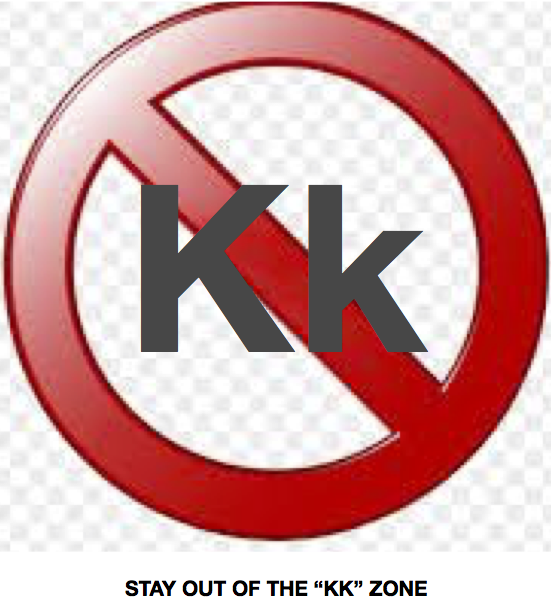 Relax your jaw. Saying “Aw” will automatically lower your jaw so that your teeth aren’t too close together. Beginners often have their teeth too close together. Keep your jaw low and relaxed.
Relax your jaw. Saying “Aw” will automatically lower your jaw so that your teeth aren’t too close together. Beginners often have their teeth too close together. Keep your jaw low and relaxed.- Pay attention to the back of your tongue. Try saying “Kk” and notice how the back of your tongue goes up? We want to avoid that. Later on, we will use this mouth position to bend notes but, for now, we do NOT want to use this mouth position. Try to keep the back or your tongue low and relaxed. Make sure the back of the tongue is not raised up into the “Kk” zone.
- Go easy. Beginners often are blowing with all of their might, like, “I’ll huff, and I’ll puff, and I’ll BLOW a single note!” Man, what did that harmonica ever do to you to make you treat it like that? The truth is a lighter, more gentle airflow is going to produce a better sounding, clearer single note. So, make sure you’re not trying to pummel the harmonica into submission here. Relax. Once again, don’t try harder, try easier.
Notice that all these solutions here have to do with relaxing: relax your jaw so your teeth aren’t so close together, relax the back of your tongue so it’s not changing the trajectory of the air, relax your diaphragm so you’re producing a nice steady, medium airflow. No wonder playing harmonica is so much fun, it requires us to relax!
Harmonica Tabs for Low Rider by War
I don’t know about you, but I’ve always loved Lee Oskar’s Harmonica on the classic song Low Rider, by War. It’s such a catchy riff.
It’s very easy to play the beginning part of this riff, and a great way to practice your new-found ability to play single notes.
-3 -3 -3 -3 -3 4 -4 3 -3 4 -3 3 -3 -3 -3 -3 -3 4 -4 3 -3 4 -3 3
The next part is a bit more tricky to play, where Lee Oskar plays it on the draw 2 because he utilizes a whole step bend. But if we play it up an octave, we can play it without any bends, like this:
-6 -6 -6 -6 -6 -6 -6 -6 -6 -6 -6 7
Here is the jam track without and with harmonica for you to play along with.
And there you have it. Congratulations! You’re starting to be able to play single notes. Remember to be patient with yourself as you’re playing with this. It may take days or weeks before you can consistently play single notes on the harmonica. Meanwhile, let me know if you have any questions. And never stop playing the harmonica, because it makes the world a better place!

Comments
Got something to say? Post a comment below.